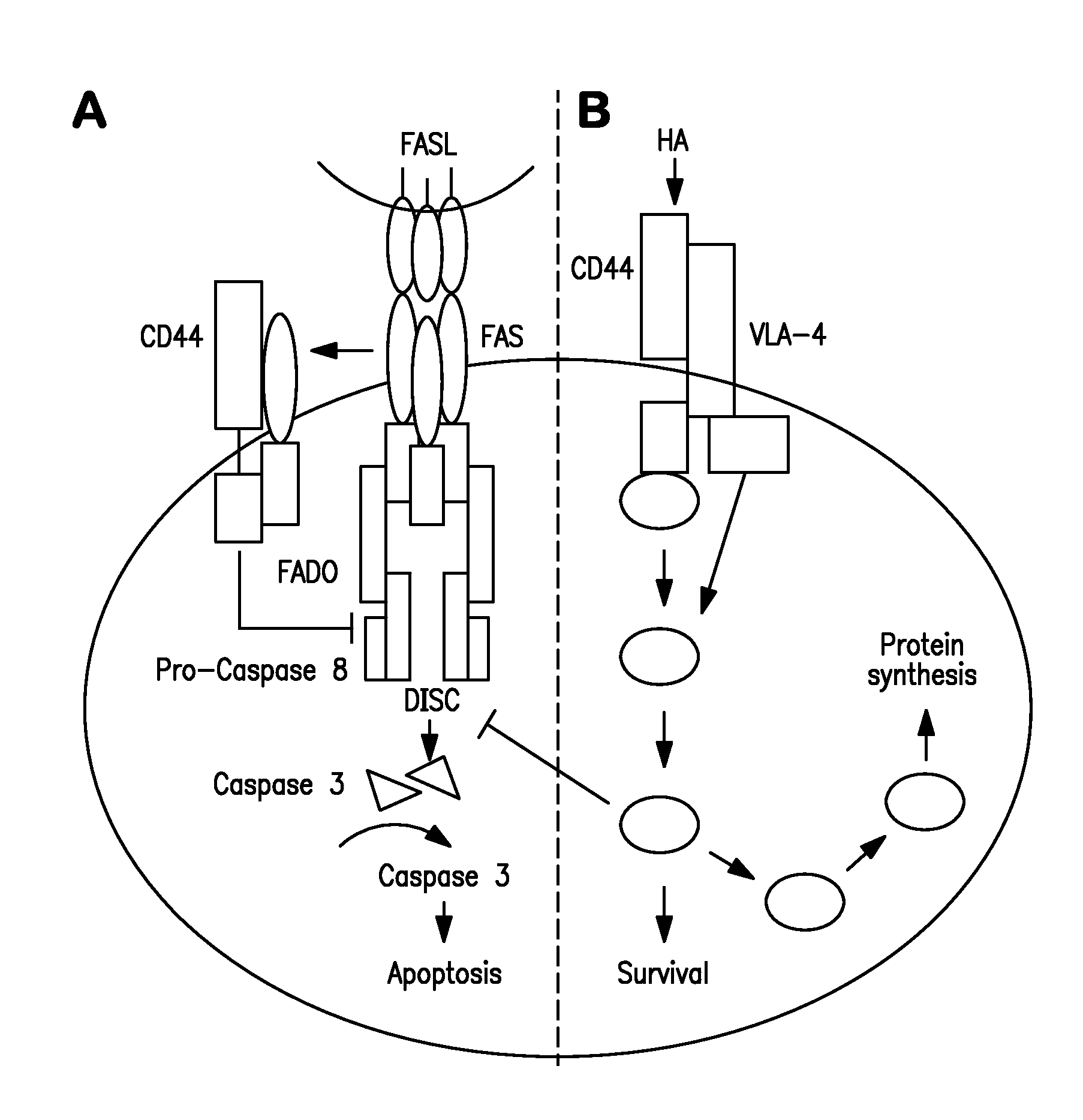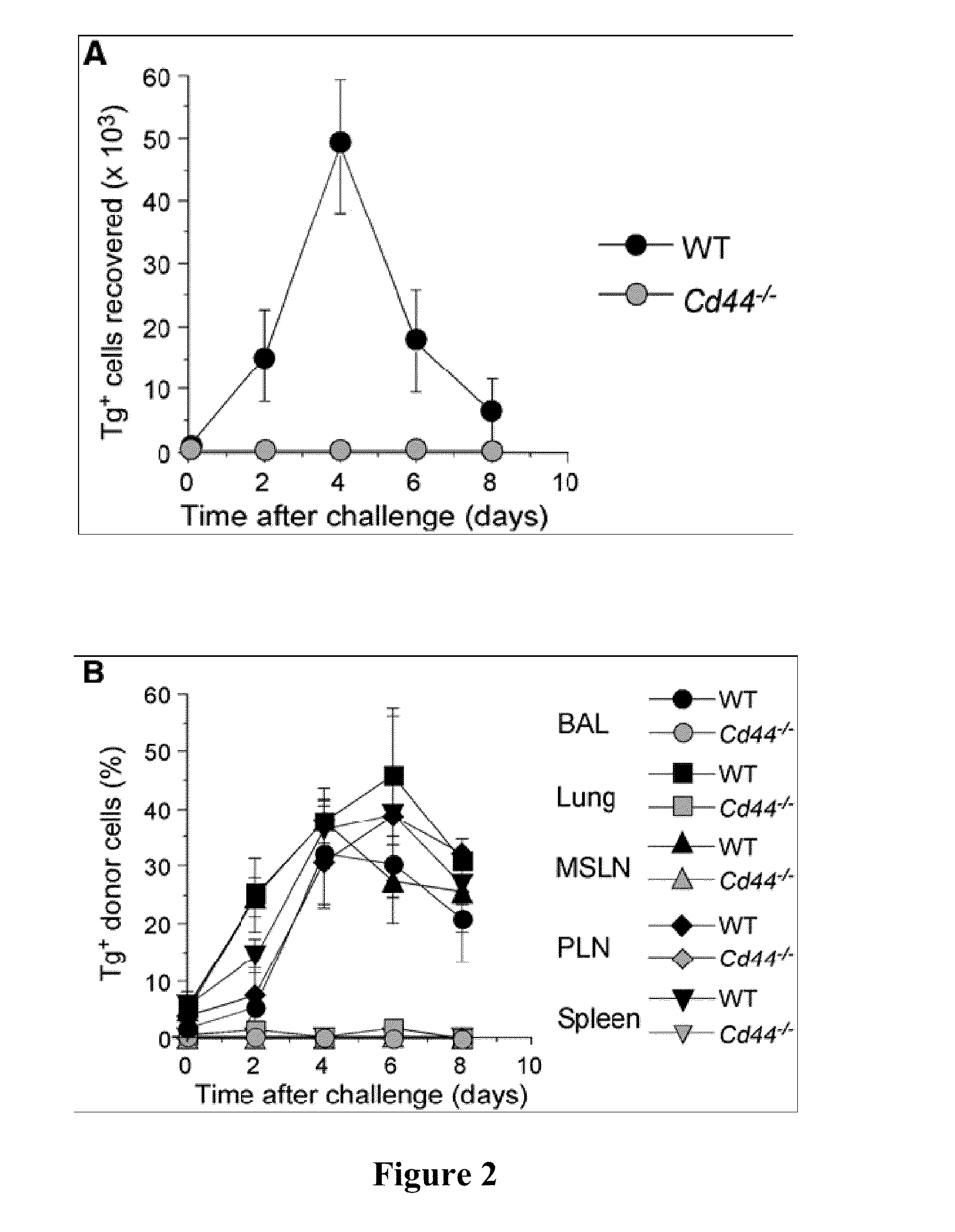Method for regulating survival and memory of t helper 1 cells
a technology of survival and memory, applied in the field of immunology, can solve the problems of difficult to distinguish direct roles in vivo, and achieve the effect of promoting effector cell survival and reducing the survival rate of th1 cells
- Summary
- Abstract
- Description
- Claims
- Application Information
AI Technical Summary
Benefits of technology
Problems solved by technology
Method used
Image
Examples
example 1
Virus and Antibody Preparation
[0082]CD44− / − mice are bred to B6PL-Thy mice and crossed to OT-I and OT-II TCR Tg mice. These mice are also crossed to B6 Ly5.1 mice. C57BL / 6 mice are purchased from Jackson Laboratories. All mice are males between 6 and 16 weeks of age.
[0083]All influenza viruses are grown in chicken eggs (10 days of embryonation) and titrated with MDCK cells for plaque-forming units (pfu) (Jelley-Gibbs et al., J. Exp. Med., 202:697-706 (2005)). Infective doses elicit an optimal T cell response and are given i.n. in 30 ml. The WT influenza A viruses Puerto Rico / 8 / 34 (PR8, H1N1) is given in a dose of 12.5 pfu. The engineered influenza A viruses William Smith Neurotropic / 33 (WSN-OVAII, H1N1) (Chapman et al., Virology, 340:296-306 (2005)) and Hong Kong Aichi / 2 / 68 (HKx31-OVAII, H3N2) (Thomas et al., Proc. Natl. Acad. Sci. USA, 103:2764-2769 (2006)) that express the OVA323-339 peptide recognized by OT-II CD4+ T cells are given in doses of 1250 pfu and 112 pfu, respectively....
example 2
Loss of CD4+ T Cell Memory in the Absence of CD44
[0091]To investigate the role of CD44 in the development of immunity, an influenza model is utilized in which viral clearance from the lung epithelium depends upon a local T cell response. In an initial comparison of wild-type (WT) and CD44-deficient (CD44− / −) mice, it is determined that CD4+ and CD8+ lymphocyte subsets are normally represented in CD44− / − mice, because of additional compensatory HA binding receptors. Moreover, differences in expression of several adhesion receptors, including CD62L, the integrins CD11a and CD49, CD45RB, and CD69 on CD4+ T cells from 6-month-old animals are not observed. Since CD44 is expressed by multiple cell types, the role of CD44 in CD4+ T cells is directly assessed with WT and CD44− / − mice crossed to OT-II TCR transgenic (Tg) mice whose CD4+ T cells recognize a peptide of ovalbumin (OVAII or OVA323-339). Naive WT and CD44− / − Tg CD4+ T cells marked by expression of the Vb5 chain of the TCR and by ...
example 3
Unimpaired Induction of CD4+ T Cell Responses in the Absence of CD44
[0096]CD44 is know to regulate T cell migration via interactions with vascular endothelium through HA, which acts to initiate extravasation into tissue. Therefore, the absence of CD44 could generally affect the trafficking of CD44− / − CD4+ T cells. Thus, the recovery of nai{umlaut over (v)}e CD44− / − and WT CD4+ T cells with time after transfer to unimmunized hosts is evaluated.
[0097]The presence of comparable numbers of naive and WT cells in the lymphoid compartment and no differences in their distribution suggest normal homeostatic regulation and migration. Since inflammation could affect CD4+ T cell trafficking and since cells from CD44− / − mice display the normal responses to TCR activation in vitro, whether the failure of CD44− / − CD4+ T cells to generate a memory effector population can be attributed to defects in trafficking of naive or effector cells after influenza virus infection is evaluated. Homing of naive ...
PUM
| Property | Measurement | Unit |
|---|---|---|
| molecular weight | aaaaa | aaaaa |
| molecular weight | aaaaa | aaaaa |
| time | aaaaa | aaaaa |
Abstract
Description
Claims
Application Information
 Login to View More
Login to View More - R&D
- Intellectual Property
- Life Sciences
- Materials
- Tech Scout
- Unparalleled Data Quality
- Higher Quality Content
- 60% Fewer Hallucinations
Browse by: Latest US Patents, China's latest patents, Technical Efficacy Thesaurus, Application Domain, Technology Topic, Popular Technical Reports.
© 2025 PatSnap. All rights reserved.Legal|Privacy policy|Modern Slavery Act Transparency Statement|Sitemap|About US| Contact US: help@patsnap.com



